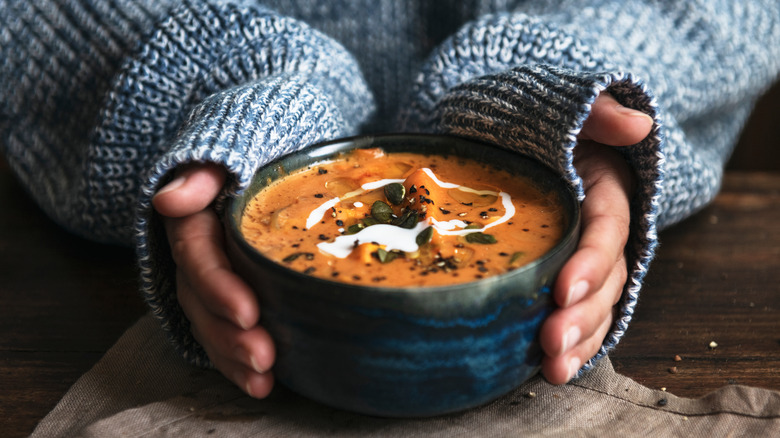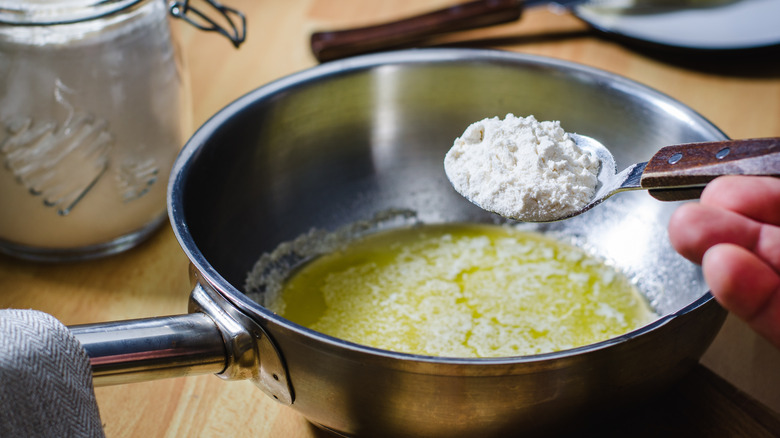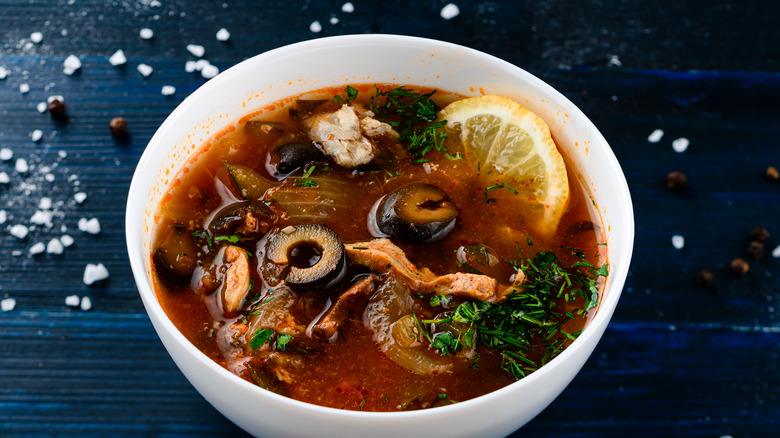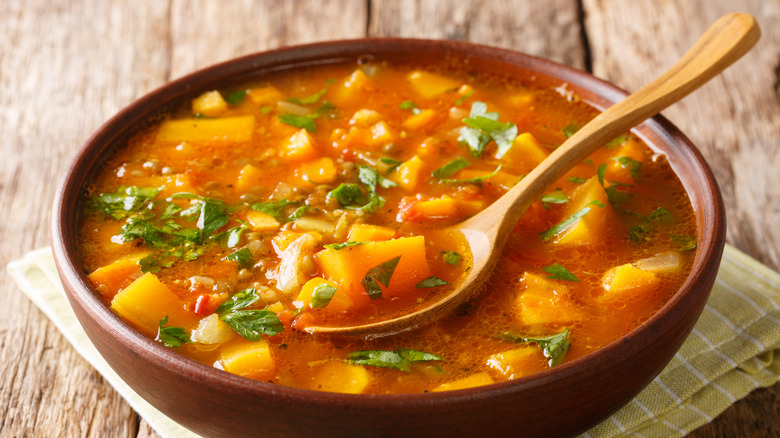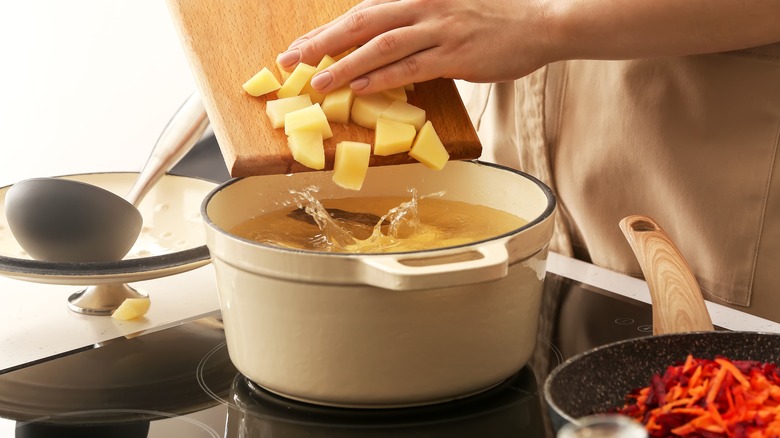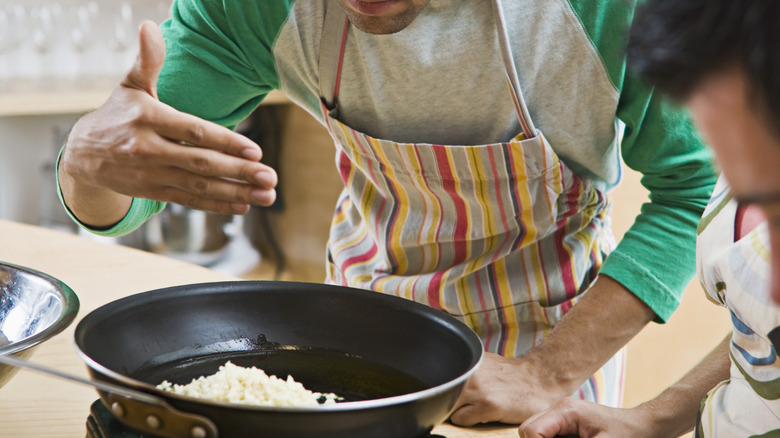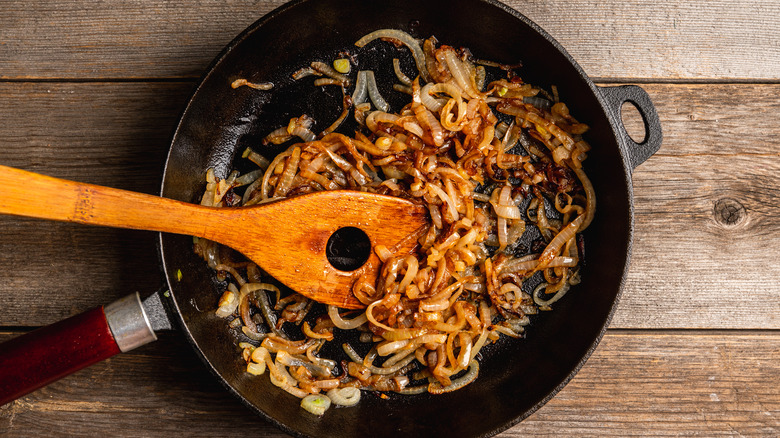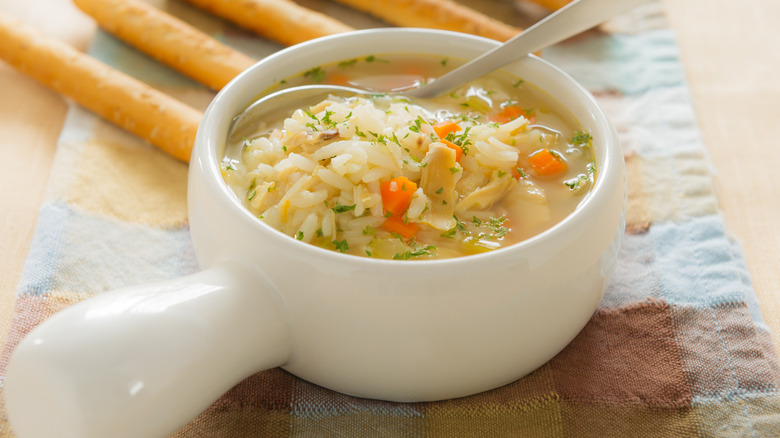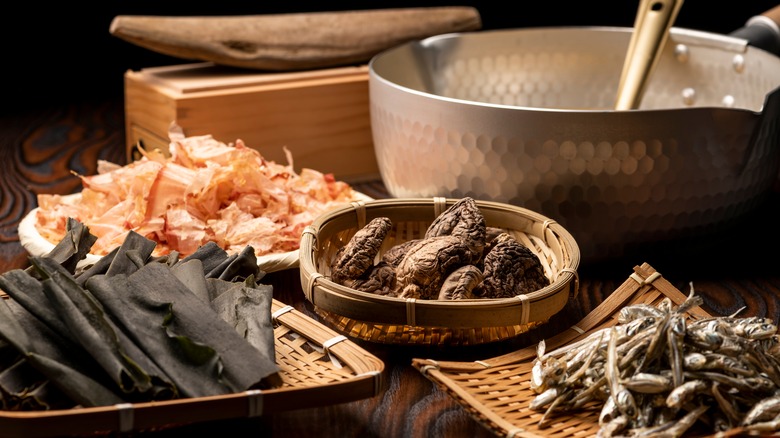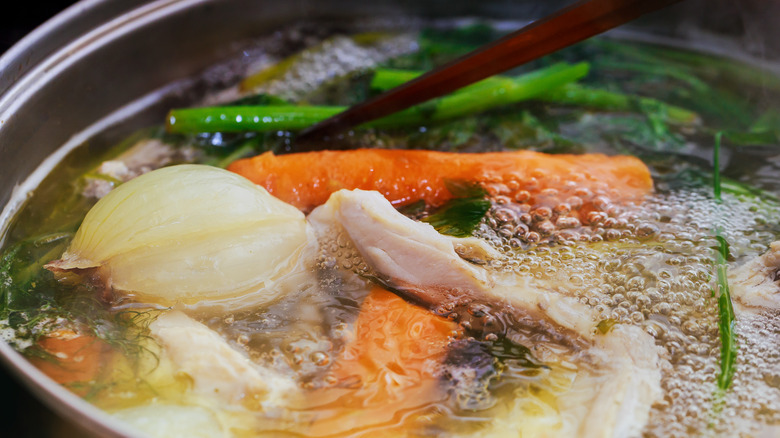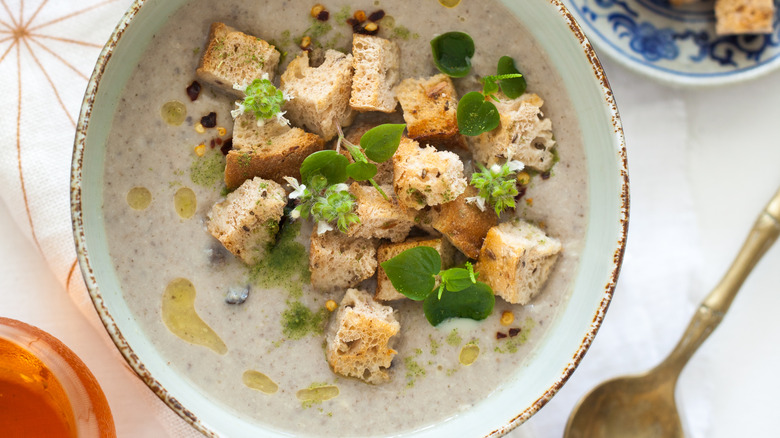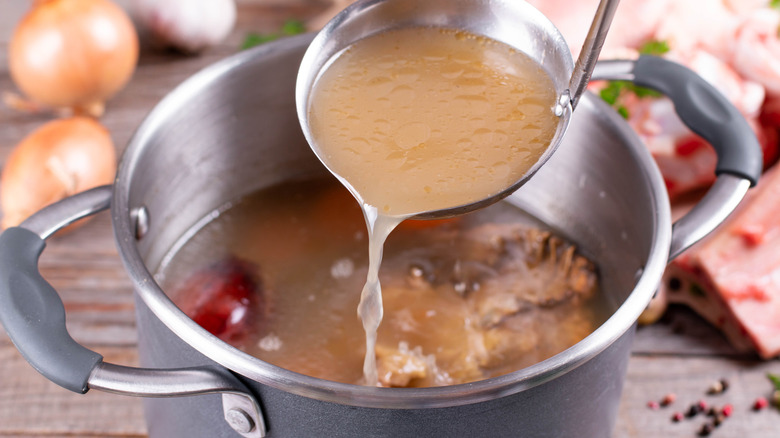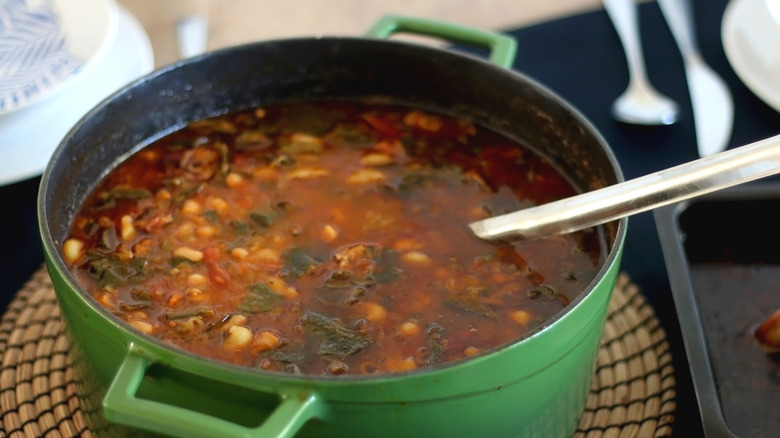Common Mistakes Everyone Makes With Soup
You don't have to wait until the leaves start to fall, and flannels come out of storage for soup season to begin. True soup enthusiasts know that soup season is a 12-month event, no holds barred. While you can make an "everything but the kitchen sink" style stew, there are a few important guidelines that will help churn out the most sumptuous, crave-worthy, belly-warming, best soup around. Keep in mind that there are common mistakes that everyone makes with soup, that can be easy to avoid.
It's likely that if you're following a recipe, step-by-step, it will include many essential elements like spicing, texture, and presentation. If you're going rogue or experimenting, there are just a few guidelines you'll want to follow, and mistakes you'll want to avoid. Whether you're making a hearty stew, a creamy chowder (or "chowdah" for those New Englanders), or blended bisque, it's important to remember a few components that can make your culinary creation go from basic to memorable. Let's get started.
Failing to thicken it properly
There's nothing worse than clumps of starch or flour in your soup, although thin and runny soup can be almost as disappointing. It can be difficult to find that perfect balance between silky and starchy, so it's best to stick to a tried-and-true method like making a roux or slurry. On the other hand, there are plenty of ways to thicken soups using whole foods, that will not compromise the outcome of flavor.
For a simple roux, whisk a bit of flour or cornstarch into your simmering fat, like butter or oil. Do this before adding too many additional ingredients, and the flour or starch will begin to dissolve. As you add ingredients, the paste will dissolve into the recipe, and eventually aid in thickening the final product, according to Southern Living.
If you haven't thought ahead and your soup is looking watery, do not fear. Consider making a slurry using a cup of liquid from your soup, mixed together with about a tablespoon of flour or starch. Whisk them together until all clumps are dissolved, and reintroduce the slurry back into your pot. Be sure to follow this sequence in order to avoid common mistakes when thickening the soup with flour.
Taking the whole foods route is just as easy! Boil a potato in your soup, remove it, and blend it with 1 cup of liquid from your broth. Reintroduce it, and enjoy.
Forgetting to add an acidic component
"What's missing?" Ah, the phrase we've all pensively muttered to ourselves, spoon in hand. Failing to add an acidic component is perhaps the most common mistake everyone makes with homemade soup. To balance flavor and mouthfeel, each dish you create should have elements of fat, acid, sweetness, and salt. Often the fat comes from butter, oil, meat, or dairy. The sweetness from caramelized onions, sugar, or the natural sugars in other cooked vegetables. Salt most commonly comes from — you guessed it — salt, but sometimes from celery, miso, or soy sauce. Acid is usually left out in the dark, even though it deserves just as an important spot in the pot.
You should always include an acidic component in your soup, so next time try adding tomatoes, coffee, sherry vinegar, or citrus fruit. If your final product is missing that pizzaz, try adding a tablespoon of apple cider vinegar, or a splash of wine to balance it out, per Mother Earth Living.
Sticking to salt and pepper
Ah, salt and pepper. The absolute minimum requirement for spicing in America, yet the most popular. Don't get us wrong, these O.G. spices have been here for us through thick and thin, but for them to reach their full potential it's important to pair them with additional spices, especially when it comes to soup making. Even if you use broth over water it's important to enhance and complement the vegetables and proteins in your pot with herbs and spices to create depth, per The University of Delaware. After all, if we wanted to drink salty water we'd take up surfing.
The beautiful thing about soup is that the herbs and spices simmer long enough that they have the ability to penetrate and infuse each ingredient. Try using minced fresh herbs, or even dried herbs in smaller quantities as they pack more of a punch, in your pot. If you're unfamiliar with using herbs and spices, try narrowing your search to the culture or region of your recipe. If you're creating an East Asian soup consider spices from that region like ginger, hot peppers, and garlic. For Mediterranean soups use parsley, basil, and oregano. For an Indian soup try coriander, turmeric, and channa masala. When in doubt, look up other recipes that carry a similar flavor profile as the soup you're making, and glean from their spice list. Start with small pinches, as the spices will flourish as the soup simmers.
Overcooking your vegetables
Great soup often simmers for quite a while. In some cases, we want our ingredients to break down and become one with the soup, like whole tomatoes or caramelized onions. But, when we want bite-sized chunks of vegetables to remain intact, it's important to add them at the correct time.
Consider staggering your vegetables, and being thoughtful about when they're introduced to the pot, per Home Cook World. For tougher root vegetables like potatoes, carrots, and beets add them towards the beginning. For firm vegetables like peppers, green beans, corn, and celery add them no more than 20 minutes before your soup is done.
For leafy greens and soft vegetables like summer squash, add them just before you plan on removing your soup from the stovetop. They will continue to cook as the soup cools down, and there is nothing worse than mushy vegetables breaking down in your dish. Delicate leafy greens like spinach can be especially unappealing when overcooked, as they can break down into mush, or even become slimy.
Forgetting to garnish
Most soups are typically beautiful on their own. Vegetables in general are quite colorful and are often a key component in soup. However, that doesn't mean it's okay to skimp on garnishing your food. Just a simple sprig of parsley, a drizzle of olive oil, or a dusting of freshly cracked pepper can make any dish go from basic to gourmet in a matter of seconds. Opt for all three and people might even start calling you Gordon Ramsay.
Garnishing can do a lot more for soup than just elevate its appearance, per Leaf. In fact, its primary purpose is to enhance the entire eating experience. That lime wedge on the rim of your black bean chili isn't just for looks. Adding an additional hint of flavor or texture to your dish can break up the monotony that can sometimes accompany soup. It can even round out an otherwise flat dish by adding a squeeze of acid like lemon, or a bit of density like cheese or oil.
Adding your aromatics too late
It's time to go pro. While we've talked about adding an array of spices to your soup, it's important to note the optimal timing for their introduction. While it isn't the end of the world to add spices as you go, there is a technique that will help to release the natural intensity of spices.
Sautéing your herbs, spices, and other aromatics in fat is the best way to release their flavor. Before adding broth or liquid to your pot, consider adding garlic, parsley, cumin, or whatever flavor enhancers you've chosen, and toast them in the butter or oil lining your pot. Do this for about 30 seconds, or until their natural aromas have been released, per CookSmarts.
Always sauté your aromatics in fat like olive oil or butter to bring out their flavors. This will not only enhance the flavor of your dish, but your kitchen will smell incredible, which is another reason why you should start toasting your spices.
Forgetting to caramelize your onions
Caramelized onions are incredibly sweet. Once they come in contact with heat, their natural sugars start to break down which, if cooked long enough, can almost taste as sweet as some fruits. When talking about added acidity, we mentioned the importance of including a component of sweetness in your pot as well. Sometimes this can come from cooking down tomatoes or including roasted vegetables like beets or butternut squash, but often times onions are the star source of sweetness in the soup.
Much like toasting your aromatics, consider caramelizing your onions, instead of adding them to the broth later on. This will give them a chance to release their natural sugars and soften quite a bit which will help them to incorporate into the broth. After adding your oil or butter to the pan, simmer the onions on high heat, and keep them moving. Do this until they begin to brown, and then reduce the heat to medium while adding enough veggie broth to cover. Let them simmer until the liquid evaporates, and voila, foolproof caramelized onions to the rescue to round out your soup. Patience is the name of the game, so start your onions while you chop up your other ingredients.
Adding grains too early
Grains, when cooked properly, add an element of texture and heartiness to soup. When added too soon, grains like rice and barley break down and become a starchy glob that your spoon wants to avoid. Little floating bits of rice are not appealing, so it's important to time adding grains just right. Luckily, heartier grains like wild rice can be a little more forgiving, so if you're not feeling confident, start with a sturdier grain as such.
In the end, it's really quite simple. Read the instructions for cooking your grain, consider the time it's meant to boil, and add your grain with that amount of time to spare. For instance, brown rice takes about 40 minutes to cook, so add the grain 40 minutes before the soup is set to be done.
Keep in mind that grains soak up quite a bit of liquid, per Oldways Whole Grains Council, so it's important to add more broth or water as needed.
Not using Umami flavors
Umami is perhaps the most overlooked of the five basic flavors, including salty, sweet, sour, and bitter. This is because it is relatively new, having been only discovered in 1908 in Japan, per Ajinomoto. The New Yorker explains that the origin of the name umami comes from the word, "umai" which translates from Japanese to "deliciousness," which is quite fitting. Today, it's not just top chefs who try to incorporate umami into their cooking, and there is a reason for its growing popularity.
This flavor group is most commonly described as savory or meaty, although it can be found in many vegan and vegetarian foods. Miso, seaweed, shiitake mushrooms, fish sauce, soy sauce, parmesan, and ripe tomatoes all contain notes of umami. Some brands have even created umami-specific seasoning and paste to aid people in rounding out their culinary creations. The flavor itself has layers of depth and can help to complete dishes that might otherwise feel light or empty.
For an easy umami addition, consider swapping salt for soy sauce or tamari. For any Asian or fish-based soups, sprinkle in a little nori. Add powdered dried mushrooms to any broth.
Not letting it simmer long enough
There is a reason restaurants market some entrees as "slow-cooked" or "slow-roasted," and it's because cooking techniques can alter the outcome of flavor and appearance, and often, the slower the better. There's a reason the crock pot was invented. Slow cooking allows for acids to cook off, sugars to break down, vegetables and meats to be infused, and herbs and spices to blossom.
There is a reason you shouldn't taste soup right after adding spices, and that's because they haven't had a chance to infuse other ingredients with their flavor and grow in intensity. Many chefs and cooking enthusiasts claim that soup is better on the second day because it's had a chance to sit, and we can't argue with that. Who doesn't love leftover soup?
Instead of boiling soup, consider letting it simmer, per Maytag. This will prevent the meat from becoming too tough, and vegetables from disintegrating. This technique will give your soup a chance to reach its full flavor potential.
Adding too much cream or oil
There is a reason gourmet restaurants serve creamy soups in such small portions. That's because they are quite rich. They most likely contain quite a bit of butter, animal fat, and salt to create a decadent dining experience. A common mistake people make when cooking soup at home is applying the "the more the better" tactic when it comes to butter, cheese, salt, and fat. While those first few bites might seem unforgettable, you will most likely not feel so fantastic after consuming a full bowl.
Start slow when it comes to adding fats, especially saturated fats like butter or lard. Instead, try thickening your soup with starches, flour, or even blended nuts as a vegan shortcut to making any soup creamy.
Soaked and blended raw cashews make a fantastic replacement for heavy cream and butter. Cashew cream can thicken any soup and works beautifully in creamy chowders and bisques. Your creation will be rich, smooth, and silky without feeling too heavy or fatty. Peanut butter is another common ingredient to give chili and root-based stews and bisques a little extra depth.
If your soup is still missing that desirable flavor of fat, consider garnishing with a swirl of olive oil, or a dash of melted butter.
Not saving your scraps
In order to get the most flavor from your ingredients, sometimes you have to get a little creative. Bay leaves or whole cloves, some inedible parts of your fruits, veggies, cheeses, and meats can help to infuse additional flavor into your soup. This doesn't mean you'll have to chop down on a chicken bone or chew through a lemon rind.
If you've added lemon to your soup, consider dropping in the whole rind to add a level of intensity that juice alone can't accomplish. For brothy soups, consider adding your parmesan rind to the simmer, then removing it before serving. The same goes for bones, vegetable tops, and even fruit skins. Just be sure you track down and remove each bone before serving to prevent injury.
If you're dealing with smaller scraps, consider adding them to a metal strainer basket and letting them steep like tea in the pot. After your soup is done, simply remove the strainer, squeeze the juices into the soup, and compost the scraps.
Even if you're not planning on using up your old vegetable scraps in your soup, save them in a plastic baggie in the freezer. Once you have a full bag, make some homemade vegetable broth by boiling them in water.
Not making enough for leftovers
Soup is arguably better on day two, so be sure to make extra. Even if you're cooking for just yourself, we recommend making at least four portions. One to eat now (because who can resist?), one for tomorrow, and at least two to freeze.
If you've ever frozen soup before, you may recognize that the thawing process can be almost as involved as the cooking process. If you intend to defrost one portion at a time, it's important to freeze portions separately. An easy way to do this is in a muffin tin. Use a ladle to fill up as many slots of a muffin tin as you can, and place it in the freezer overnight. In the morning, crack the cups of frozen soup out into a freezer bag, and when you're ready to defrost a portion, grab a few of the disks of soup.
You can also freeze a single portion in freezer baggies. Fill the bag and pat it flat on the bottom of your freezer. Once it's frozen solid, you can stand it on its side, and line it up with your other frozen soup portions. Don't forget to label them with the type of soup, top allergens, and date cooked.
Playing it safe
Soup can be as simple as mixing a container of broth with a bag of frozen vegetables. If you're looking to become more experimental and creative in the kitchen, soup is a great place to start. Although we've just listed out the common mistakes everyone makes with soup, there is not much you can do to soup to make it truly inedible.
Start by selecting a vegetable or recipe of choice. Look up similar recipes, or recipes using that key ingredient until you have a handful of them. Once you get the gist of what ingredients complement the soup best, log off and get cooking.
If you have a knack for cooking, you may feel bold enough to add coffee or cocoa powder to your chili, or lemon rind to your lentil soup, but if you're not quite there yet, start with some common seasonings. Remember, choose ingredients from similar regions if you're feeling stuck. Anytime you're unsure, do a taste test by scooping out a cup of your masterpiece in progress, add a little of your experimental ingredient and give it a try. If it's a success, add it to the whole pot. If not, keep on trying. Soup doesn't have to be boring, and this is your chance to spread your culinary wings.
For experts looking to broaden their horizons, choose a vegetable you've never cooked with before, and see what you can do with it. Let's get cooking.
